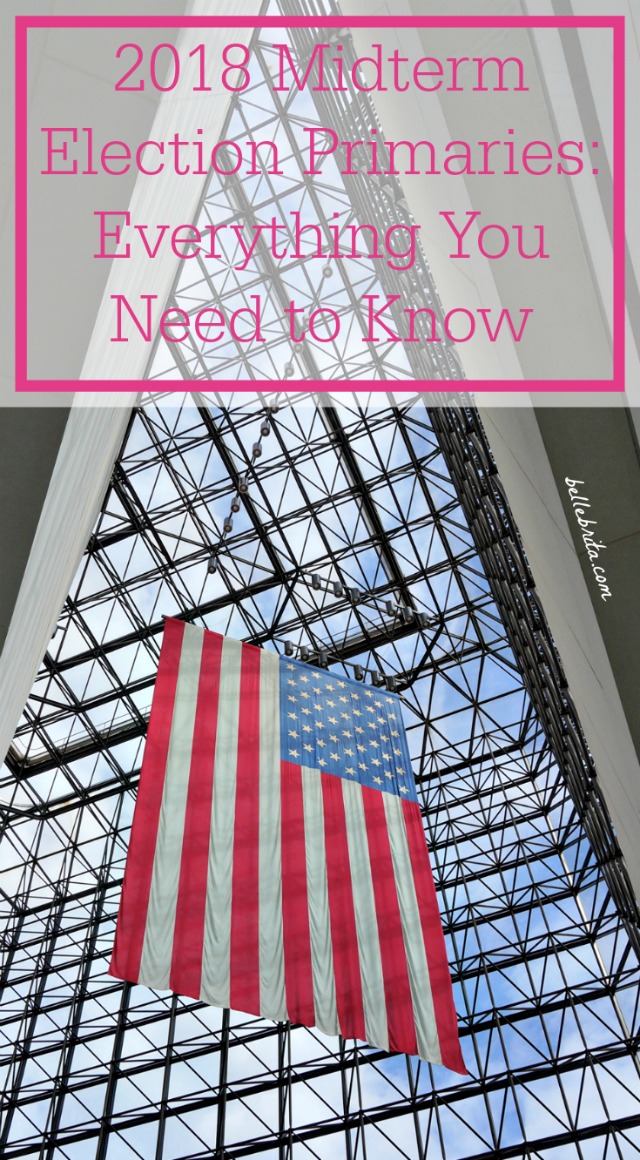It’s 2018! After the disastrous election year in 2016, it’s a chance to vote again. The midterm elections are coming up in November, but before that happens, we need to get through the midterm election primaries.
Are you looking for information about the 2018 midterm elections? I have a new post with all the details!

Why should I vote in the midterm election primaries?
Broadly speaking, voter turnout in the general presidential election is dismal. It’s even worse during the midterm elections and practically nonexistent in the primary midterm elections. In the midterm election primaries, every single vote makes a difference.
All representatives are up for reelection. Roughly 1/3 of senators are up for reelection. This is true at both a state and a national level. Depending on where you live, you might also have a governor’s race.
If you want to vote for a good candidate in November, you first have to vote among a selection of good and bad candidates in the primary elections. Otherwise, you end up in a 2016 presidential election with Donald Trump and Hillary Clinton. That’s what happens when people don’t bother to show up for the primary elections. A handful of voters decide the two main candidates. Do you really want that to happen again?
By voting in the primary midterm elections, you help create a better ballot for the general election.
How do I vote in the primary midterm elections?
It’s relatively easy to vote in the primary midterm elections. First, you need to register to vote. Then you need to vote in the appropriate primary midterm election in your state.
Voter registration
Registering to vote has never been easier. Multiple websites allow Americans to register to vote.
Just fill out the short form. Bam! You can vote in your state’s primary midterm election.
Depending on where you live, you can also register to vote in person at your local library, at the DMV, or at another government office.
How do I know if I’m registered to vote?
If you voted in the 2016 presidential election and you haven’t moved, you’re probably already registered to vote! If you didn’t vote in 2016, or you’ve moved since then, you can use the interactive map at Nonprofit Vote to find voter registration details for your state.
First select your state. Then click on the button “Check Your Registration.” This will take you to your state’s website. Finally, fill out the form. Then you will know if you’re registered to vote or not.
Where should college students register to vote?
Depending on your home state and where you attend school, you can register to vote with your permanent address or your school address. Look at Campus Vote Project for your state’s guidelines. If you’re attending school out-of-state, look up both your home state and your school’s state.
Is it too late to register to vote in the midterm election primaries?
Each state has its own requirements on voter registration deadlines. For the earliest primary midterm elections, yes, it’s too late to register to vote. However, you should still register to vote in case there’s a runoff election. Plus it’s important to vote in the general midterm elections in November.
Ballotpedia has its own interactive map to find voting policies and deadlines in each state.

Absentee Voting and Early Voting
An absentee vote is a vote cast by mail in advance of Election Day. Generally, if you vote absentee, you do not vote in person on Election Day.
3 states offer voting by mail: Colorado, Oregon, Washington. This eliminates the need for separate absentee voting.
20 states require a valid excuse to vote absentee. Find the full list on Ballotpedia. Common valid excuses include having to work, having a chronic illness or disability, or being away from your county on election day. As a college student, I voted absentee a few times since I was away at school on Election Day.
27 states and Washington D.C. allow any citizen to cast an absentee ballot. Read the full list on Ballotpedia.
How do I vote absentee?
Rock the Vote makes it easy to find your state’s details on absentee voting. Choose your state from the interactive map. From there, look at the gray table of information on the left. Find the link about absentee voting in your state.
You can also return to the interactive map at Nonprofit Vote.
Is absentee voting the same as early voting?
Absentee voting and early voting are not the same. With a few exceptions, you cast an absentee ballot by mail. When you vote early, you still vote at a polling location. States vary on whether or not you need a valid excuse to vote absentee. However, you don’t need an excuse to vote early.
7 states don’t offer early voting, but they do allow absentee in-person voting, with a valid excuse. These states are:
- Delaware
- Kentucky
- Mississippi
- Missouri
- New York
- South Carolina
- Virginia
How do I vote early?
The majority of states offer early voting. Once again, you can find out about early voting dates and places by selecting your state on the interactive map at Nonprofit Vote.
View the whole list of states and early voting dates on Vote.org.
The following states do not offer early voting, nor do they offer in-person absentee voting. These states are:
- Alabama
- Connecticut
- Michigan
- New Hampshire
- Oregon*
- Pennsylvania
- Rhode Island
- Washington*
However, in both Oregon and Washington, you vote by mail. You can’t vote at the polls. At both of those links, you can find your ballot drop box if you don’t want to send in your ballot by mail.
Voter ID Requirements
Just skimming voter ID requirements confuses me. Thus I will just direct you to a few resources to find out what sort of ID you need to 1) register to vote and/or 2) cast a ballot.
NCSL: Voter ID Laws (a general overview, plus charts with state information)
Vote.org: Voter ID Laws (for voting in person and for voting absentee)
USA.gov: Voter ID Requirements (voter registration, provisional ballots, types of ID, and more)
When are the 2018 midterm election primaries?
This is the current 2018 election schedule. I’ve marked special elections with a single asterisk * and primary runoff elections with a double asterisk **
Tuesday, March 6: Texas primary
Tuesday, March 13:
- Pennsylvania special House general election*
- South Carolina special House runoff election* **
Tuesday, March 20: Illinois primary
Tuesday, April 24: Arizona special House general election*
Tuesday, May 8:
- Indiana primary
- North Carolina primary
- Ohio primary
- West Virginia primary
Tuesday, May 15:
- Idaho primary
- Nebraska primary
- Oregon primary
- Pennsylvania primary
Tuesday, May 22:
- Arkansas primary
- Georgia primary
- Kentucky primary
- Texas primaries runoff**
Tuesday, June 5:
- Alabama primary
- California primary
- Iowa primary
- Mississippi primary
- Montana primary
- New Jersey primary
- New Mexico primary
- South Dakota primary
Tuesday, June 12:
- Maine primary
- Nevada primary
- North Dakota primary
- South Carolina primary
- Virginia primary
Tuesday, June 19: Arkansas primaries runoff**
Tuesday, June 26:
- Colorado primary
- Maryland primary
- Oklahoma primary
- Utah primary
- Mississippi primaries runoff**
- South Carolina primaries runoff**
Tuesday, July 17:
- Alabama primaries runoff**
- North Carolina primaries runoff**
Tuesday, July 24: Georgia primaries runoff**
Thursday, August 2: Tennessee primary
Tuesday, August 7:
- Kansas primary
- Michigan primary
- Missouri primary
- Washington primary
- Ohio special House general election*
Saturday, August 11: Hawaii primary
Tuesday, August 14:
- Connecticut primary
- Minnesota primary
- Vermont primary
- Wisconsin primary
- South Dakota primaries runoff
Tuesday, August 21:
- Alaska primary
- Wyoming primary
Tuesday, August 28:
- Arizona primary
- Florida primary
- Oklahoma primaries runoff
Tuesday, September 4: Massachusetts primary
Thursday, September 6: Delaware primary
Tuesday, September 11:
- New Hampshire primary
- New York primary (tentative date)
Wednesday, September 12: Rhode Island primary
Tuesday, November 6: Louisiana primary, General Election Day for all states
Tuesday, December 4: Georgia runoff election for state and local offices**
Saturday, December 8: Louisiana general election
If voting is important to you, please share this post with your friends and family. Together we can make a difference. Voting is a privilege and a responsibility, one that I’m honored to use this year and every election year.
